Anyone who’s lived in an apartment will understand the problem of upstairs neighbors stomping. I’ve been there myself. Living in an apartment building can be great, but once you get noisy upstairs neighbors, it can be difficult to find peace in your home.
Loud upstairs neighbors were one of the main inspirations for me getting into soundproofing. As such, it’s an issue I’m pretty much an expert in.
In this article, I’ll offer my top tips for how to deal with upstairs neighbors stomping. The solutions here are permanent so are probably more geared towards homeowners. If you need help as a tenant, I recommend checking out my other article on how to reduce noise from upstairs.
Why Do Upstairs Neighbors Stomp?
It’s fair to assume that, most of the time, your upstairs neighbor isn’t being noisy on purpose. The reason you can hear them walking around is mainly down to physics and how sound waves propagate through a structure.
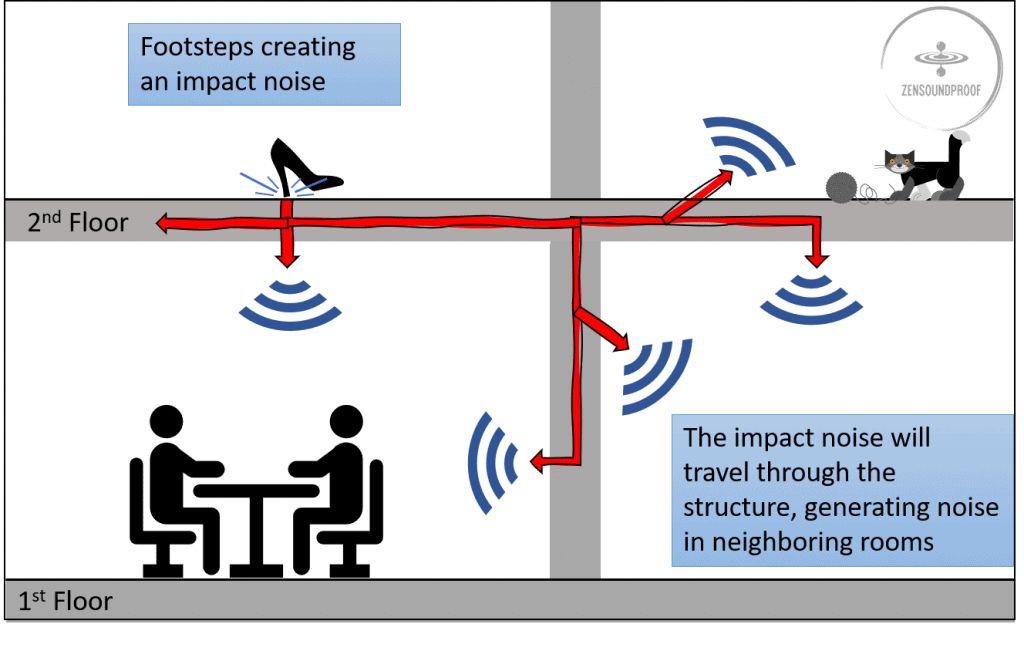
Sound waves are vibrational energy, which passes through a medium – this can be air or a solid object. In this case, we’re interested in impact sounds because we’re dealing with footsteps making noise on a floor.
My other article on reducing noise from upstairs lists some tips for airborne sound, which is less of a concern.
Is it Normal to Hear Upstairs Footsteps?
It’s normal to hear upstairs footsteps, although the severity of the problem depends on numerous factors. For example, you’ll hear them more if your loud neighbors wear shoes in the house, and if they have hard floors.
Stomping is what’s known as impact noise. This is where sound is created through an object making contact with a surface (your upstairs neighbor walking around). We can deal with impact sounds in 2 main ways:
- Flooring material. Carpet is softer and so provides a level of damping and absorption. Wood transmits impact sounds more effectively because it’s rigid.
- Ceiling thickness. Thickness implies numerous layers of material, or even surface decoupling. The bottom line is that, generally, a thicker surface will be more difficult to vibrate.
Identifying Types of Upstairs Noise
In this article, I’ll focus specifically on stomping noise. While this is just footsteps, some possible scenarios include:
- Dancing (includes loud music too)
- Running/jogging – your neighbor might exercise in their upstairs apartment
- Loud walking – your neighbors might just be heavy-footed
Generally, the type of stomping noise – and the pattern of when it occurs – won’t have a massive impact on the solutions you can try. When it will matter, however, is if you plan to raise a complaint. I’ll discuss this in more detail later in this article.
Preventative Measures: Soundproofing and Noise Control Options
Your options for installing soundproofing materials may be fairly limited depending on whether you’re a renter or a homeowner. In this section, I’ll suggest a few of the most effective options for controlling the amount of noise that passes through the floor into your ceiling.
I’ve written more in-depth articles about most of these topics, so I’ll include links to pages where you can find out more.
1. Soundproofing the Ceiling
The most obvious place to start when dealing with noisy upstairs neighbors stomping is your ceiling. Soundproofing a ceiling is possible without turning it into a massive construction project.
In fact, there are 4 main options for how to soundproof a ceiling without construction. We’ll focus on 2 here because they’ll be the most effective:
- Decoupling Your Drywall Ceiling
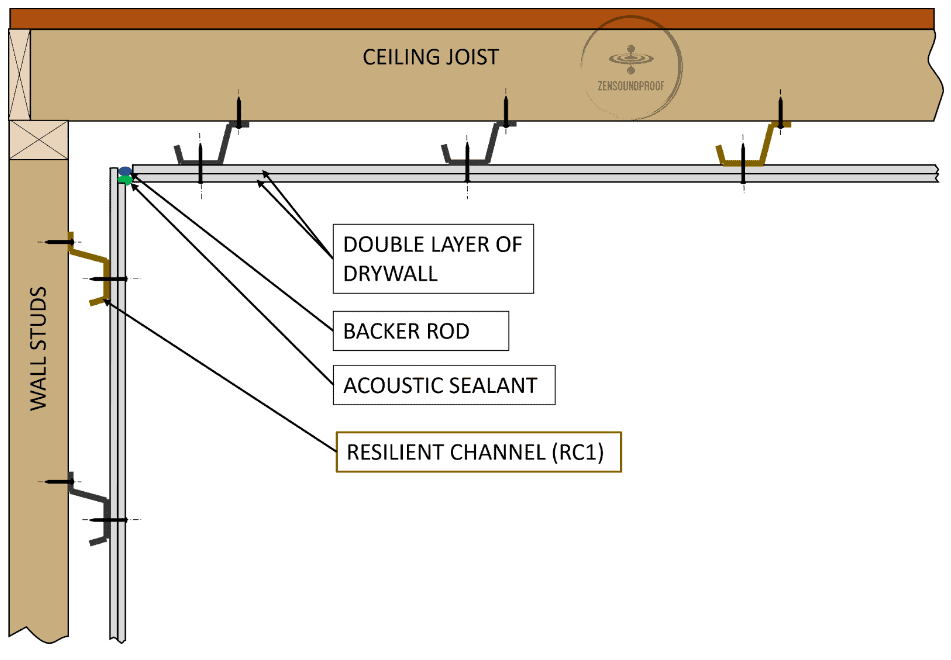
If your ceiling is drywall and you believe it’ll be easy to work on, the most effective option will be decoupling. In short, this involves completely separating the ceiling from the joists using metal channels and rubber clips.
Doing so breaks the transmission pathway – the route sound waves take to pass through the structure.
The installation isn’t too complex, as it involves screwing the channels to the joists, fixing the clips to them and then hanging a new layer of drywall.
You can find the full method in my article about soundproofing ceilings.
- Building a Suspended Ceiling
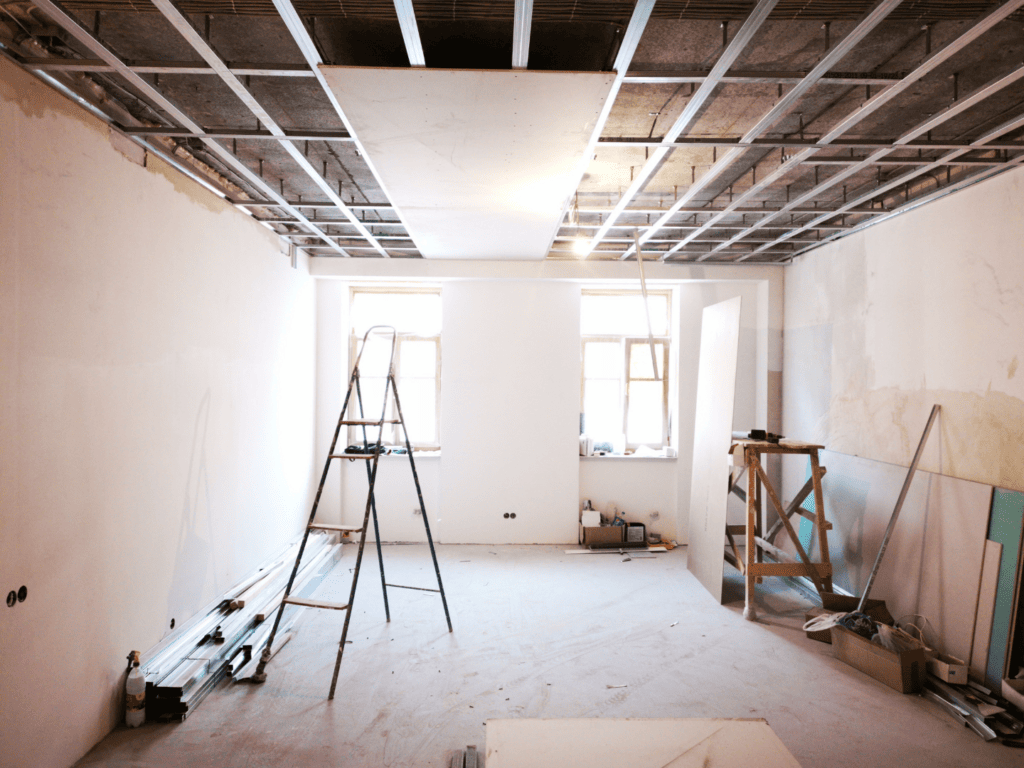
A suspended ceiling is less work than a decoupled ceiling. It involves installing metal channels under the existing joists, which have ceiling tiles fitted into them. If you go down this route, I recommend looking at soundproof ceiling tiles.
There are 2 important points to consider with this option:
1. Suspended ceilings take up quite a bit of room, as the cavity is usually designed for wiring, ducting, etc. As such, you might find your ceiling ends up being too low.
2. The cavity can create an echo chamber, making sounds appear louder. To get around this, you’ll want to use acoustic ceiling tiles and some kind of cavity insulation. Both materials help absorb sound.
While a suspended ceiling is easier to install, a decoupled ceiling will be more effective.
2. Floor Noise Control
If you have access to the floor that’s being stomped on, your best bet will be to address this, too. Damping the noise at the source will help reduce how much transmits into the building structure, in turn reducing how much you hear come through the ceiling.
There are loads of ways to soundproof a floor depending on the type of noise you’re dealing with. For convenience, we’ll focus on ones that don’t involve any kind of construction, which are:
- Adding Soundproof Underlays
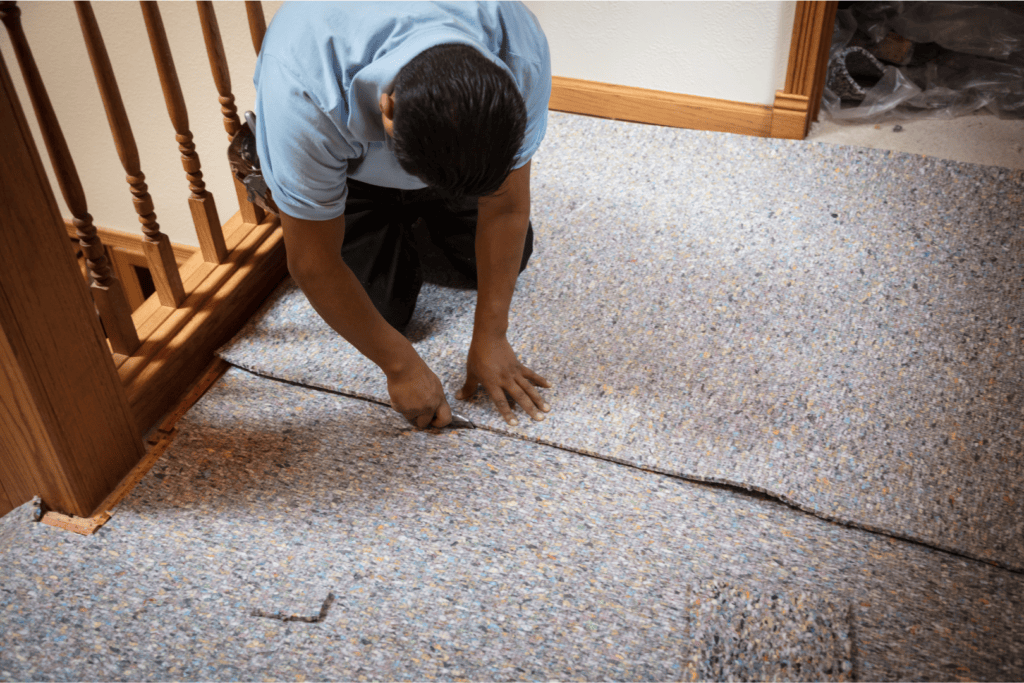
Floor underlayment can help provide a level of decoupling between the rigid floor material and the building structure. To achieve this, you’ll want underlay made from resilient materials, such as foam, rubber, cork, and felt.
I have an article on the best soundproof floor underlays, so look through that to find some options.
Of course, to install an underlay, you’ll have to pull up the current flooring (or put the underlay over the top). However, as the name suggests, underlay shouldn’t be the floor material itself – it needs something over the top.
Asking your neighbors to rip up their floor might not be the best option to stop stomping. Soundproof underlay will be ideal if you’re dealing with upstairs noise in your own home or if you own the apartment where the noise originates.
- Installing Floor Mats
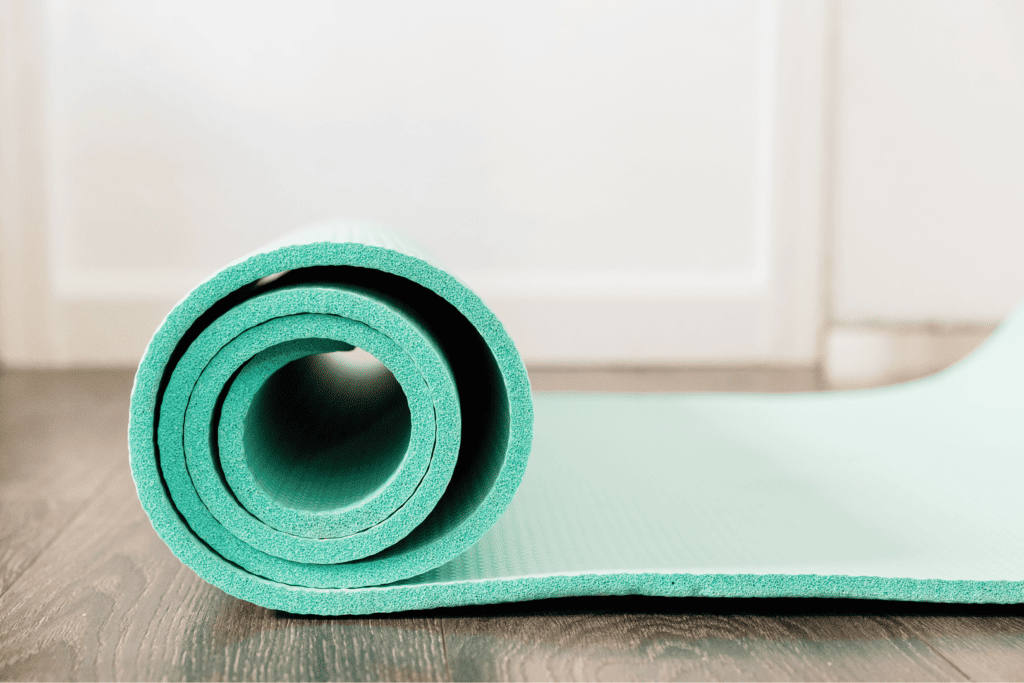
A much easier option is to use floor mats. The best soundproof floor mats are made of resilient materials. EVA foam is a common choice, but soundproof floor mats can also be made from composite materials.
Floor mats will be a much easier sell to upstairs neighbors. If you’ve already spoken to them about the noise levels, you could consider buying them some floor mats and asking them to use them.
However, the main downside of floor mats is that they don’t cover the whole floor. Most are designed to be used under rugs, so they’re not massive. It means that if you want the decoupling effect they offer, all stomping will have to happen on the mat.
3. Personal Noise Control
While not ideal, arguably the cheapest and least confrontational option is personal noise control. What do I mean by this? Well, there are 2 options:
Use Noise-Canceling Earwear

First, you could try some kind of noise-canceling earwear. This might be earplugs, such as those you’d use for sleeping or working in loud environments. Sure, it’s not ideal, but wearing ear plugs could have a massive impact on the amount of noise you can actually hear!
When I was an exchange student in Canada, my host’s footsteps would wake me up every morning. I started wearing earplugs to sleep, and it made a massive difference to the quality of my stay.
By extension, though, they’ll also impact your ability to watch TV or listen to music. But if you want some peace, such as when going to bed, ear plugs will probably be the quickest and easiest option.
Listen to Music to Drown Out the Noise

Similarly, you could just play your own loud music to mask your noisy upstairs neighbors. This might not be massively effective, as impact sounds can be quite intense, meaning your music would need to be loud to completely mask it. Try to avoid this where possible, as you don’t want to annoy upstairs neighbors!
A good workaround would be to use noise-canceling headphones. My article has a list of OSHA approved noise-canceling headphones, so they’ll protect your hearing without going too loud.
Alternatively, if the noise levels from your neighbors aren’t too bad, you could consider using a white noise machine. A white noise machine will be a good compromise for when you’re sleeping, as it’s more relaxing than listening to music.
Approaching Your Neighbor: Techniques and Tips for Positive Communication
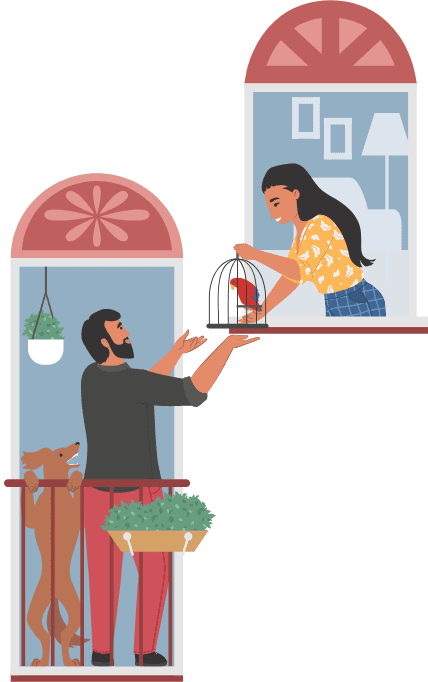
When dealing with a noisy neighbor, it can be easy to forget that they might not be aware of what they’re doing. After all, they won’t have any idea how it sounds unless they have their own noisy upstairs neighbors.
So, if you can hear upstairs neighbors stomping around, it might be worth trying to talk to them. Here are some tips for doing this.
Start with Direct and Honest Communication
This is a bit of a no-brainer, but start by speaking to them. Don’t mention the stomping just yet – you’ll want to make sure you’re introduced to your noisy upstairs neighbor before you jump into a complaint.
Explain the Noise Issue
Once you’ve established communication, explain the problem. It’s vital that you do so respectfully and without any kind of hostility. Remember to:
- Pick the right time. Try not to just run into them in the hall or speak to them at a busy time. A weekend might be best if they work. You should know their schedule well if they’re that noisy, so work with it!
- Use the right tone and medium. Consider speaking to them in person and make sure you’re polite.
- Avoid accusations or threats. Another no-brainer, but don’t accuse them of anything. Use phrases like “it probably doesn’t seem like it but…” or “you might not be aware”.
- Lead with solutions. Where possible, don’t just say “keep it down”. Try offering solutions, such as them wearing slippers, using rug pads, etc. This might seem a bit presumptive, but just asking them to be quiet doesn’t necessarily address the exact issue or what they can do about it.
Make sure you keep a log of any and all communications you have with them about the noise coming from their apartment.
Leave a Note as a Follow-Up
If the initial conversation seemed to go well, make sure you leave them a polite note as a follow-up. It doesn’t need to be much more than “thanks for your time”, other than to include your cellphone number.
Of course, if they’re hostile or disagree with your assertions, you probably won’t want to leave a note. Either way, make sure they have your cell number so it’s clear you’ve done everything you could.
Be Patient and Request their Assistance
Asking for their assistance might not seem like an obvious route, but it can help you reach an agreement. For example, you could buy them some rug mats and ask them to install them.
Whatever you choose to do, make sure you’re patient and give them time to correct their behavior. Just make sure you don’t build any kind of revenge machine!
Legal and Extreme Options: When All Else Fails
If you’ve tried speaking to your neighbors and things haven’t improved, going down the legal route might be worth considering. Bear in mind, though, that this is the nuclear option and will ruin any kind of relationship you have with them. Also, consider the impact it could have on your relationships with your other neighbors.
The legal route of making a noise complaint will typically follow these steps:
Recording Your Neighbor
Recording your upstairs neighbors loud footsteps is objectively the best way to gather evidence to use in a noise complaint. After all, you can hardly claim they’re making noise if you have no proof.
The legality around this is a bit gray. For example, some states run on single-party consent for audio recordings, whereas others are two-party. However, nothing is really stopping you from making a recording in your own home, even if it’s of a noisy neighbor.
It might be worth speaking to some kind of mediator first and logging this conversation. A mediator might include your HOA, the police, your building management, etc. Essentially, you’ll want someone to know you’re recording your neighbor for the purpose of a noise complaint.
Some tips for making these recordings include:
- Use an obviously relevant device, such as a sound meter, microphone, decibel app, etc.
- Make sure you keep a written log of when the recordings are made, in what room, for what purpose, etc.
- Never share the recordings with anyone outside of the noise complaints process. Specifically, don’t make them public for any reason.
You’ll likely need to record upstairs neighbor stomping around, but this can be difficult. Make the recordings in your home and be sure not to record any private information. We’re focusing on neighbors stomping here, so make sure that’s all you record.
Involving External Authorities
A noise recording on its own won’t be much use – you’ll need someone to show it to. There are a couple of different options you can take, but I recommend working down this list in order and exhausting each one before moving to the next.
Building Management or Landlord
Your first stop after speaking to your neighbor should be your building management, HOA, or landlord. They should be able to speak directly to your neighbor and put a bit more pressure on them to keep quiet.
Of course, if your neighbor denies making noise or comes up with an acceptable excuse, there’s not much more a landlord can do. Even so, this should be your first option before moving on to something more drastic.
Calling the Police
Next, consider involving the police. Your city or state should have some kind of noise ordinance and complaints department, such as this one from New York City. The police will generally only get involved if you’ve submitted a noise complaint or if there’s concern of excessive noise or it’s related to something illegal.
Check online whether your city or area has a noise complaints department. Most do, and they usually come under Environmental Health. This can be a very effective option when coupled with police involvement, as it can lead to fines and perhaps even prosecution.
Filing a Lawsuit
Finally, you could try filing a civil lawsuit against your loud neighbor. You can absolutely sue your neighbor under a private nuisance claim for excessive noise. You’d do so in small claims court, meaning the financial settlement could be as much as $25,000 depending on your state’s laws.
However, it can be a difficult thing to prove, as you need to demonstrate some kind of disturbance on your part. Also, you need to prove that your neighbor is causing the noise.
Rather than suing for money, you could get an injunction put in place to force your neighbor to be quiet. Make sure you gather evidence, such as dates, times and noise levels, and file a police report.
Take it all to a small claims court and they’ll guide you through the rest. You shouldn’t need to hire a lawyer – it’s easy enough to do all this on your own.
FAQs
Can my upstairs neighbors hear me as much as I hear them?
The short answer to this question is no. At worst, your upstairs neighbor will hear your music, watching TV or you talking – all of which are airborne noises. Unless your walls are made of paper, these should be fairly muffled. An upstairs neighbor won’t hear you walking around your apartment. If they can, it shouldn’t be a disruptive level of noise.
Why do some people appear inconsiderate?
In the context of noisy neighbors, it’s worth bearing in mind that they might not be aware of what they’re doing. From their perspective, they’re just walking around their apartment. Make sure you talk to them and try to resolve the issue. Of course, if they have their own noisy neighbors and they carry on stomping then they are inconsiderate.
Final Thoughts
I hope this article has given you some tips for dealing with upstairs neighbors stomping. Don’t underestimate the value of communication and make sure to log all interactions you have with them regarding the noise issues.
Have you dealt with neighbors stomping in the past? Did you manage to resolve the problem? If so, I’d love to hear any advice you might have.
